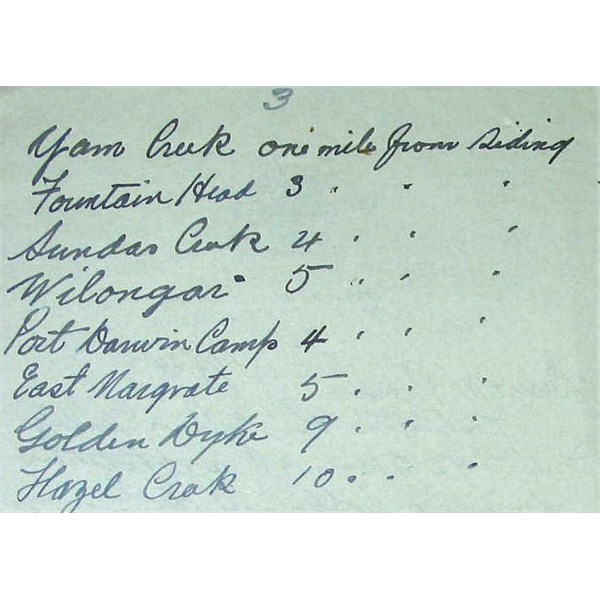Monday, Sep 15, 2014 at 02:57
It's hard to say what that is Ron, It could be any one of the names in the photo I have posted here or it could be Brocks Creek.

Names
Brock's Creek was the first area in which gold was discovered in the Northern Territory. It was discovered by William Brock a Government Assistant Inspector of Works with the Darwent and Dalwood Overland Telegraph Construction team in 1870. Brock's Creek Township was officially gazetted on 5 May 1898 and was named in honour of William Brock. By 1886 Brock's Creek had the largest Chinese
population in the Northern Territory which at one time it was reported reached 400 people. The township and
railway siding is important as a former centre of
population on the NT goldfields and an important military supply base and detention centre during World War II. Brock's Creek growth in importance was centred around the local mining industry which developed in the area. Some of the first mining leases were taken out by Europeans but were soon transferred to Chinese interests by 1889. The area is also notable for the infamous mining companies operating in the Northern Territory at the time and who had vast interests in the area. A majority of these companies were originally registered in London, England. It is also notable for the investment by local syndicates and finally for the takeover of one of the major mines in the area, Zapopan, by the Commonwealth Government in 1910. The site is of high social significance as a former commercial and meeting centre for the district. Brock's Creek
Railway Siding was specifically established to cater for and serve the interests of the mining companies and residents in the area. This was because the location of the original
railway siding at Fountain Head was ill conceived and inconvenient subsequently costing the mining companies valuable money, time and resources. The
Railway Siding served as a transport link to the pastoralists in the area. Vesteys who had large holdings in the area used the railway to transport cattle to
Darwin for their live export business to the Philippines. The growth of Brock's Creek was due mainly to the commercial and economic potential and success of the immediate area. The township had a number of interesting and famous residents associated with it including Thomas George Crush who was the proprietor of the Federation Hotel and later the member for the Northern Territory in the South Australian Parliament. The hotel was the hub of "posh" society and was regularly visited by members of "
Darwin Society" and many social events were held there and at the
Mine Managers Residence. His wife Fanny Haynes is
well known in the Northern Territory as the proprietor of the Federation Hotel after her husband's death. The site is of high historic and social value. The townsite consists of the four original blocks auctioned in 1898 on which the foundations of the original store and Federation Hotel remain. The
railway siding consists of the railway line, loading ramp, shunting area and the
toilet dating from pre World War II. Brocks Creek Military Detention Barracks was constructed in early 1942 utilising the existing Police buildings and the slabs of the earlier school buildings. It was popularly known as "Belsen" to the soldiers and civilians at the time. It is a reminder of the disciplinary measures employed by the Australian defence forces during World War II and is the only surviving example of this form of military installation in the
Katherine-
Darwin region and the Northern Territory. The site is also significant culturally and socially through its association with Government Administration Policy of the time by the continuous Police presence on the site from 1898-1953 and the establishment of schools from 1906-1917. The site contains the fabric of the former Police Structures dating from the 1890s as
well as that of the two school buildings dating from 1906 and the Detention Barracks from World War II.
Description: Brocks Creek Township: The site contains a range of features including the remains of the Federation Hotel consisting of the concrete floor surfaces and a collapsed
well; a raised earth surface within concrete abutments representing the fuel drum filling shed platform; foundations of the fuel storage tanks; remains of military quarters and mess room foundations consisting of concrete slabs; remains of the military power house site consisting of a concrete slab; an arrangement of earth filled 44 gallon drums and large sand dump said to have been the waste dump of a ballast crusher.
Railway Siding: This group of sites covers an area about 500m x 120m and consists of an earth platform, railway latrine, main line and siding loop, and remains of military BIPOD siding and F.S.D. spur line sites. Military Detention Barracks: The site covers an area about 250m x 300m and contains a number of structural sites and relics situated on the former police and hospital
reserves. The remains of the earlier police site comprise a number of structural floor surfaces of varying composition, pathways and
rock-edged garden plots. The earlier police station is thought to have occupied the southern-most and most substantial of these floor surfaces which comprises carefully selected flagstones set in concrete, concrete and bitumen over concrete. On the eastern side a pathway of broken concrete slabs leads to a former structural site, possibly a cell
---
FollowupID:
823701